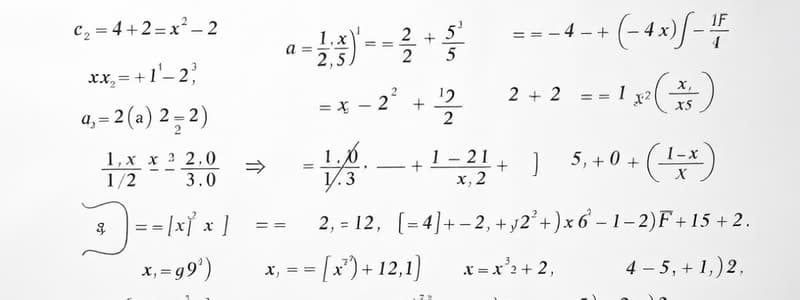Podcast
Questions and Answers
What is the restriction for the value of b in an exponential function?
What is the restriction for the value of b in an exponential function?
- *b* must be greater than 0 and not equal to 1 (correct)
- *b* must be greater than 1
- *b* can be any real number
- *b* must be less than 0
In the exponential function $f(x) = a imes b^x$, what does the a-value represent?
In the exponential function $f(x) = a imes b^x$, what does the a-value represent?
- The multiplier for the exponential growth
- The horizontal asymptote
- The initial value or y-intercept (correct)
- The rate of decay
Which of the following describes the transformation represented by the function $g(x) = 3^x - 7$?
Which of the following describes the transformation represented by the function $g(x) = 3^x - 7$?
- A vertical translation 7 units down (correct)
- A horizontal translation 7 units down
- A reflection across the x-axis
- A vertical stretch by a factor of 3
What characteristic of the function $f(x) = 2^x$ indicates its behavior as x approaches negative infinity?
What characteristic of the function $f(x) = 2^x$ indicates its behavior as x approaches negative infinity?
For the function $f(x) = 5^x + 2$, what does the '+ 2' signify in terms of graph transformation?
For the function $f(x) = 5^x + 2$, what does the '+ 2' signify in terms of graph transformation?
Which property of exponents expresses the following: $x^{a+b} = x^a imes x^b$?
Which property of exponents expresses the following: $x^{a+b} = x^a imes x^b$?
In the case of the exponential function $f(x) = a imes b^{x}$, what does the graph typically show in relation to the horizontal asymptote?
In the case of the exponential function $f(x) = a imes b^{x}$, what does the graph typically show in relation to the horizontal asymptote?
What happens to the graph of an exponential function when it is multiplied by -1?
What happens to the graph of an exponential function when it is multiplied by -1?
Flashcards
Exponential Function
Exponential Function
A function of the form f(x) = a * b^x, where 'a' is the initial value and 'b' is the multiplier. 'a' cannot be 0 and 'b' must be greater than 0 and not equal to 1.
What does 'a' represent?
What does 'a' represent?
The initial value of the exponential function. This also corresponds to the y-intercept of the graph, (0, a).
What does 'b' represent?
What does 'b' represent?
The multiplier, or factor, that determines the rate of growth or decay in the exponential function. It represents the constant ratio between consecutive y-values when the x-values increase by 1.
Horizontal Asymptote
Horizontal Asymptote
Signup and view all the flashcards
Transformation: Vertical Translation
Transformation: Vertical Translation
Signup and view all the flashcards
Transformation: Horizontal Translation
Transformation: Horizontal Translation
Signup and view all the flashcards
Transformation: Vertical Stretch/Compression
Transformation: Vertical Stretch/Compression
Signup and view all the flashcards
Transformation: Horizontal Stretch/Compression
Transformation: Horizontal Stretch/Compression
Signup and view all the flashcards
Study Notes
Exponential Functions
- An exponential function is of the form f(x) = a • bx
- Restrictions: a ≠ 0, b > 0, b ≠ 1
- a-value represents the initial value or y-intercept (0, a)
- b-value represents the multiplier/factor or constant ratio
- Exponent properties: xa • xb = xa+b, (xa)b = xab, x-a = 1/xa
Exponential Function Characteristics
- y-intercept: The point where the graph crosses the y-axis (x = 0)
- For f(x) = a • bx, the y-intercept is (0, a)
- Horizontal Asymptote: A horizontal line that the graph approaches but never touches
- Equation of the horizontal asymptote: y = a
- Domain: The set of all possible x-values for the function
- Usually all real numbers, written as (-∞, ∞)
- Range: The set of all possible y-values for the function
- Usually (0, ∞) if a > 0
- Increasing/Decreasing: Determine if the function values increase or decrease as x increases
Transformations of Exponential Functions
- Vertical Translations: Adding/subtracting a constant from the function.
- g(x) = f(x) + k (shifts up k units) or g(x) = f(x) - k (shifts down k units)
- Horizontal Translations: Changing x.
- g(x) = f(x + h) (shifts left h units) or g(x) = f(x - h) (shifts right h units)
- Vertical Stretches/Compressions: Multiplying the function by a constant (a factor)
- g(x) = a • f(x), if |a| > 1, it stretches vertically, if 0 < |a| < 1, it compresses vertically
- Horizontal Stretches/Compressions: Changing x by a constant.
- g(x) = f(bx) compresses horizontally if |b| > 1, stretches horizontally if 0 < |b| < 1
- Reflections: Multiplying the function by -1
- Reflections occur over the x-axis if g(x) = -f(x) or over the y-axis if g(x) = f(-x)
Studying That Suits You
Use AI to generate personalized quizzes and flashcards to suit your learning preferences.




